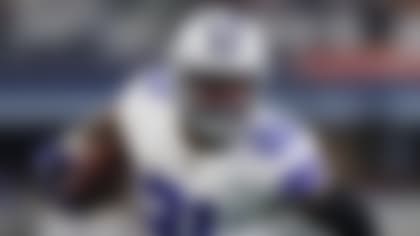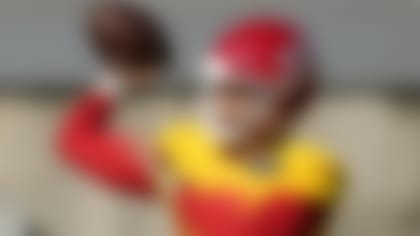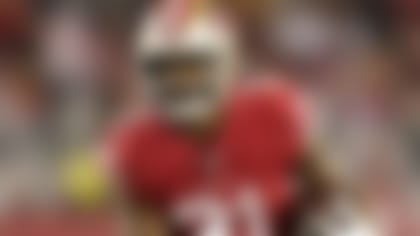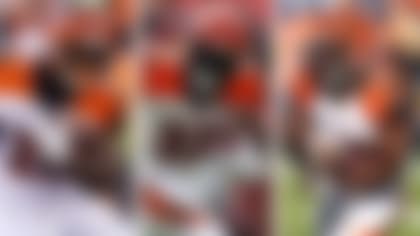This was published before Steve Johnson's reported torn meniscus. San Diego's depth will be tested if he cannot make a speedy recovery.
Jamison Crowder made waves in late June when he asserted that the Washington Redskins boasted the best receiver group in the NFL. Naturally, the second-year slot receiver's comments spawned discussion and rankings all throughout the football world.
It seemed that in the aftermath of the original Crowder comment all the talented receiver groups got their due. The young duo in Jacksonville of the solid Allen Hurns and burgeoning superstar, Allen Robinson, were an easy mention. The Jets don't have much depth behind Brandon Marshall and Eric Decker, but their firepower was enough to get noticed. The same could be said for the Broncos veteran duo of Demaryius Thomas and Emmanuel Sanders. Not many batted an eye at Jamison Crowder's comments, as their suddenly deep group of pass-catchers offers a variety of skill-sets. Most everyone rightfully anointed the three-deep Arizona Cardinals as the best wide receiver corps in the NFL.
Even groups like the Steelers were floated out if Martavis Bryant wasn't suspended, or the Dolphins if DeVante Parker hits his ceiling. However, one group was strangely absent from the majority of these discussions.
The San Diego Chargers quite clearly have one of the five best wide receiver corps in the NFL.
The conversation starts with Keenan Allen, who in his third NFL season established himself as a premier player at his position. Before going down in Week 8 with a freak kidney injury, Allen was on pace to finish with 134 catches and over 1,400 receiving yards. He completely took over games against the Packers and Lions, catching a combined 90.6 percent of his targets in those two weeks.
Losing Allen proved too much for the Chargers offense to withstand. Philip Rivers' yard-per-attempt dropped from 8.06 to 6.53, and his touchdowns-per-game from 2.25 to 1.38 after Allen went down for the remainder of the season. The third-round draft pick out of Cal established himself as a true difference maker in 2015.
Keenan Allen doesn't check all the boxes of the prototypical No. 1 receiver. He doesn't have the size-speed combination of Julio Jones, the overwhelming physicality of Dez Bryant or the proclivity for the fantastic catch like Odell Beckham. It doesn't matter. Allen succeeds with his elite precise route-running and detailed understanding of the technical aspects of the game.
Reception Perception is a methodology I developed to help quantify a wide receiver's performance as a route-runner. The system samples eight games out of a 16-game NFL season to provide a picture of both how a team uses the receiver and how successful he is at getting open versus coverage. The methodology is the ideal way to present just how proficient a wideout Keenan Allen is.
In Keenan Allen's 2015 Reception Perception sample 58.4 percent of his 298 routes were either slants, curls or posts. Last season San Diego made excellent use of the short to intermediate passing game. Allen was the primary driving force of the aerial assault, consistently thumping defenses with those crossing patterns.
Given Philip Rivers' strength as an accurate passer, it makes great sense for the Chargers to pick teams apart in the short game. Of course, that "death by a thousand paper cuts" approach only truly works if you have an elite separator to funnel the targets through. The step forward Keenan Allen took last year solidified that he can indeed be that player to carry the passing attack.
Allen posted those elite-level scores on the routes he ran most often. His success rates on slant (86.2) and curl routes (88.4) are within the 90th percentile of NFL scores charted over the last three seasons. Allen's 80 percent success rate on post routes is also a top-notch score.
Some of that assigned route portfolio causes observers to label Keenan Allen a possession receiver, glorified slot or some other seemingly pejorative term. However, several of his Reception Perception metrics strongly rebuke that idea. His 77.1 percent overall success rate vs. man coverage is the third best score recorded in Reception Perception history, behind only Odell Beckham (80.1) and Antonio Brown (79.7).
When you think of slot receivers and these other possession archetypes, defeating tight physical coverage and plucking the ball in traffic don't fit the mold. Allen is adept at both skills with a 79.6 percent success rate vs. press and a sterling 82.6 contested catch conversion rate. Those aren't numbers of a volume-inflated receiver, those are numbers of a true anchoring No. 1 receiver.
Keenan Allen was on pace for 134 receptions and over 1,400 receiving yards last season before going down with that freak kidney injury. He was in the middle of his true breakout and reputation establishing season in 2015 after a great rookie campaign followed by a slower sophomore year. With Allen back in action, look for him to produce right up there with the top receivers in 2016. He's an excellent value in the second-round of fantasy drafts and will likely produce numbers akin to a first-round wideout when all is said and done.
You can tell the Chargers have a preferred type at the receiver position. Steve Johnson joined the team in free agency last year and he plays the game in a similar style to Allen. Johnson came to Chargers as an under the radar addition but carried a strong Reception Perception profile. The veteran was off to solid start as the primary slot receiver in San Diego with 14 catches, 173 yards and two touchdowns on just 17 targets in the first three weeks. He was an ideal chain-moving slot receiver that fit right into San Diego's up-tempo pass attack.
Unfortunately, injuries struck and Johnson couldn't build off that momentum. He did finish off the year with a seven-catch, 92-yard and one score game against Jacksonville in his final appearance before his season ended.
Johnson was a No. 1 receiver in his heyday for Buffalo, racking up three straight 1,000-yard seasons from 2010 to 2012. When many questioned if he still had anything left after a quiet 2014 season in San Francisco, Reception Perception revealed he could still play. His 76.1 percent success rate vs. man coverage and 86.7 percent against press still stand as some of the better scores among NFL slot receivers.
Johnson is one of the more creative route-runners and creates timely separation for his quarterbacks. He boasts above average success rates on slants, curls, outs, comebacks and flat routes. If he's healthy in 2016, he'll fit right back into the primary slot receiver positon in the San Diego offense. He just turned 30 years old and is far from finished. He's not a major factor on the fantasy radar at this moment, but could push for 80 catches if this offense fires on all cylinders. Going completely ignored, he's at worst a fine dart throw late in MFL10s.
Keenan Allen and Steve Johnson carry similar Reception Perception profiles as elite short to intermediate separators. They allow Philip Rivers to execute on the quick timing-based passes that fit his anticipatory style. In 2015 they just thumped teams with those crossing routes the duo excels at, and it will continue to be the basis of the passing game. However, that brand of offense only works if you have a counterpunch to keep defenses from constricting the short areas of the field.
For years, San Diego's counter punch at the receiver position was Malcom Floyd. The longtime Charger retired this offseason, but you could tell how much the team valued that role by how quickly they moved to replace him with a younger, yet similar asset. The Chargers handed a four-year, $24 million dollar contract to Travis Benjamin early in free agency.
Benjamin had a breakout season with the Browns in 2015 tallying 966 yards on 68 catches playing on the league's 30th ranked scoring offense. Yet, the football world was ready to label him as a fluke from the very start of his breakthrough year.
Benjamin ran 257 routes over his eight-game sample from 2015, and you'll be unsurprised that 44.3 percent of them were slant and go-routes. There's wisdom in asking players to just do what they do well over and over again. Benjamin's 65.1 percent success rate on go-routes is one of the top deep scores recorded in the methodology. It puts him fifth all time behind only established elite players like Antonio Brown (73.3), Odell Beckham (74.3) and Dez Bryant (67.2) and the NFL's best deep threat in DeSean Jackson (74.6). Anytime you see a score pushing the 60 percent range you're broaching into the territory of some of the NFL's vertical threats, but a data point like Benjamin's is special.
Two of Benjamin's other highly run routes, the slant and post, are perfect for the timing-based passing attack San Diego runs. He also demonstrated great ability to sell the deep route before breaking off to the more shallow portions of the field. Often times, when a player is that good as a deep threat, you just want them to be competent in the other portions of the game. Benjamin's 80.4 percent score on slants and 75.8 percent on posts are well above the NFL average for each pattern, showing he passes the test with more than just competence.
Travis Benjamin will fill the field-stretching role in the Chargers receiving corps and has all the ability to thrive in doing so. Not only will his dangerous speed open up space for Allen and Johnson to get open with precise routes underneath, but he'll also contribute major big plays with his ability downfield. Benjamin's success rates on other routes like the slant and comeback (80 percent success rate) show he can be the type of nuanced receiver that will also chip in at other parts of the game plan besides the vertical plays.
Benjamin goes off the board anywhere from the eighth round in MFL10s to the 11th round in more casual drafts. He doesn't require more than a WR4 investment, which makes sense given questions about his target share and week-to-week consistency in the stat sheets.
When pursuing the wide receiver corps throughout the rest of the NFL, it's hard to come up with many groups from one to three to match the Chargers. Reception Perception reveals they have a true No. 1 in Keenan Allen, a dangerous playmaker in Travis Benjamin and the slot receiver technician to complete the mix in Steve Johnson. Each offers a unique skill set to the table and fits comfortably into their role.
The Chargers also have some depth that shouldn't go unnoticed. Dontrelle Inman has produced when called upon to step out of his No. 4 receiver positon. The team has a potential big-time sleeper in 6-foot-4 and 205-pound Tyrell Williams out of Western Oregon. Williams ripped off a 4.42 40-yard dash and 39.5-inch vertical jump at his 2015 Pro Day. If any of the top-three were to struggle with injuries again this upcoming season, they have players who could step in for them.
If you add in veteran tight end Antonio Gates and Danny Woodhead, who tied the NFL lead in running back catches (80) last year, the Chargers offense is littered with high-end passing game weapons. With a top-five receiving corps and fine ancillary assets, this aerial attack could be set to explode in 2016, especially if the defense does not improve.
San Diego added some fine pieces to their defense in Casey Heyward and No. 3 overall pick Joey Bosa (who is still unsigned), but they'll need more than that to drastically improve Football Outsiders' DVOA 25th ranked defense. The Chargers ranked first in plays per drive and Rivers led the NFL in pass attempts last season and have little reason to scale back their tempo.
All of this weaponry and projected game scripts intersects back at Philip Rivers, who is perennially underappreciated in both NFL evaluation and fantasy circles. He goes off the board anywhere from the 9th to 13th round in current fantasy drafts. Ken Whisenhunt helped Rivers' career get back on track in 2013 and he returned as the team's offensive coordinator in the offseason. The team ranked sixth in pass yards during his last stint in San Diego. The team may want to establish Melvin Gordon, but his own play and their team construction with riches in the passing game dictate where the emphasis will go.
We need to start giving the Chargers more attention and respect as potentially one of the best passing offenses in the NFL. A stable of high-end pass catchers attached to a high-end accurate passer bring a tantalizing mixture. Don't be surprised if all of their air players exceed expectations in 2016.
Matt Harmon is an associate fantasy writer/editor for NFL.com, and the creator of #ReceptionPerception, who you can follow on Twitter _@MattHarmonBYB_ or like on Facebook.











